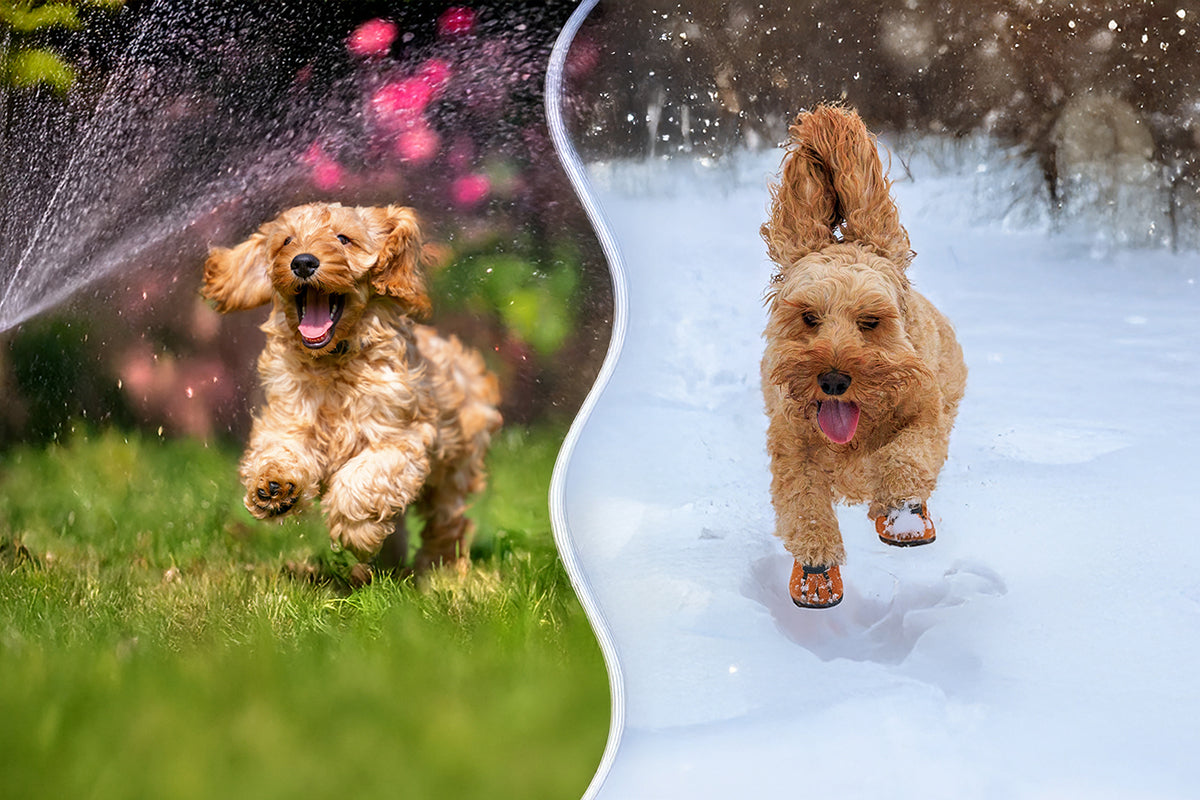
Seasonal Health Concerns for Pets: What to Watch Out for Year-Round
Your pet's needs change right along with the seasons. From frostbitten winter paws to overheating in the summer, dogs and cats face unique challenges all year long. By understanding the risks that come with changing temperatures, you can take simple steps to keep your pet safe and happy.

Winter Health Concerns and How to Solve Them
As temperatures drop, pets can face a number of risks in the winter that you want to watch out for.
Hypothermia
Pets left outdoors in cold weather are in danger of developing hypothermia. Keep them indoors if you can so they stay toasty and warm.
Sometimes, you may care for pets that have to stay outside, like feral cats. In these situations, provide a dry, warm shelter to protect them from the elements. One great option is the K&H Thermo Outdoor Kitty House. It has two exits covered by clear door flaps to protect outdoor cats from the elements, along with a warming pad so they stay toasty. It's great for use in garages, porches, or barns.
You should also make sure that outdoor water bowls don't ice over with the K&H Thermal-Bowl Heated Outdoor Water Bowl. It prevents water from freezing, even in sub-zero temperatures.
Frostbite and sensitive paws
During the winter, dogs and cats are at risk of frostbite, especially on the more exposed parts of their body like noses, ears, and paw pads — yet another reason why it's best to keep them indoors where they're protected from the elements.
If you do take your dog or cat outside, be sure you take precautions. For example, when you take your pup outside for potty breaks or have short play times with your kitty, protect their paws with little booties. If they don't wear paw coverings, be sure to wipe their paws with a damp cloth when you come inside in case they stepped on rock salt or other chemicals used to melt snow.
Individual cold tolerance
A dog or cat's cold tolerance can vary. A young dog with long fur may be able to handle a longer walk than an older dog with a short coat. If your dog or cat has short fur, they might even prefer wearing a pet coat to keep them warm if you take them outside for short breaks.
Your pet's health can also impact their cold tolerance. Pets with diabetes, kidney disease, heart disease, or Cushing's disease, for example, can't regulate their body temperatures as well. Your veterinarian can help you understand your pet's limits.
Arthritis support
Even if your pet doesn't step a paw outside in the winter, they can still be affected by the cold. Cold weather can worsen some medical conditions like arthritis, especially in older pets. You can help alleviate your pet's cold weather discomfort by providing a toasty place to sleep, like the K&H Thermo-Pet Lounge Sleeper Heated Cat & Dog Bed. This bed has a removable heating pad that warms to your pet's normal body temperature and a soft bolster that makes the bed extra cozy.
Or get the waterproof K&H Pet Bed Warmer and insert it in your pet's favorite indoor bed to make it extra toasty. The warmer has automatic heat control to keep it at a cozy temperature and can be a great comfort to pets with issues like arthritis or hip dysplasia.
Dry skin
Indoor heating during winter months can reduce humidity. Repeatedly coming in from the cold into a heated house can leave your pet's skin itchy and dry. Signs that your indoor air may be a little too dry include increased static electricity, noticing your own skin is dry, or your eyes feeling irritated. You can help alleviate this issue by using a humidifier in your home and towel drying your pet as soon as he comes inside.
Toxic substances
Antifreeze is deadly to pets, but the sweet taste can attract animals anyway. Even small amounts can be lethal. Wipe up any antifreeze spills immediately and keep household chemicals stored safely away.
You should also be cautious about salt or other products used to de-ice sidewalks and driveways, as these can be toxic to your pets as well. So be sure to wipe down their paws when they go inside if they weren't wearing booties.
Don't forget to also store human food in containers your pets can't get into. The winter holidays bring lots of sweet treats, like chocolate, that are toxic to cats and dogs.
Summer Health Concerns and How to Solve Them
Warmer months bring their own unique challenges.
Heatstroke
Pets can quickly overheat in hot weather, putting them at risk of heatstroke. Symptoms of heatstroke include heavy panting, glazed eyes, rapid heartbeat, difficulty breathing, lethargy, fever, and dizziness. If you notice any of these symptoms in your pet, you should see a veterinarian right away.
To help reduce the risk of heatstroke in the summer, avoid midday walks. Try to take your pet out during the cooler parts of the day, like the early mornings or evenings. And when they are outside, make sure they have access to shade and water.
But whether your pet is indoors or outdoors, you can help them cool down on warm days with a cooling bed like the K&H Cool Bed III Cooling Dog Bed. It requires no electricity and contains no toxic gels. Just fill it with water, and it's ready to use!
Dehydration
Dehydration can happen fast during warmer months. Make sure your pets have constant access to fresh water, especially during outdoor activities. If you're taking your dog for a walk, bring a water bottle and water bowl with you. And whether you're at home or on the go, consider using a K&H Coolin' Bowl. This bowl keeps fresh water cold for up to 15 hours. Activate the cooling crystals by filling the interior with water and freezing overnight.
Sunburn
You might be surprised to learn that pets can get sunburns, particularly those with light-colored coats like Siamese cats or thin coats like Dalmatians. Areas like the nose, ears, and belly are most at risk. And just like with humans, sunburns and sun exposure can lead to skin cancer down the line.
Use pet-safe sunscreens to help protect sensitive areas, and try to take your pets outside only in the cooler parts of the day.
Paw burns
The hot pavement can burn your pet's paws. When taking your dog or cat for a walk or potty break, use the grass rather than pavement and walk in the shade. Remember, pavement can heat up fast in the summer. For example, if it's 95°F outside, blacktop pavement might get as hot as 140°F, cement 125°F, and red brick 135°F.
Car dangers
In the summer, leaving your pet in the car alone puts their life at risk quickly. On a warm day, temperatures inside your vehicle can quickly rise to dangerous levels. Even if it's just 70°F outside and the car windows are slightly open, your car's interior temperature can get up to 110°F in just an hour. So never leave any pet in the car alone. And when you're traveling together, keep the AC running.
Be Ready for the Seasons
Each season brings its own set of adventures and challenges for your pet. But with a little extra attention, you can help your pet enjoy the best that each season has to offer. Remember to keep an eye on the weather and make adjustments as needed. Then you and your furry best friend can enjoy all the seasons together.






